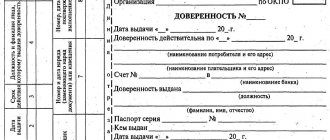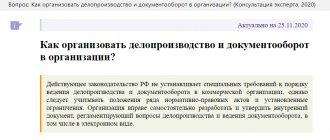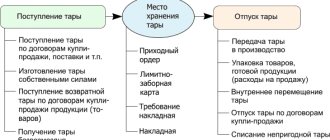General provisions of accounting policies in trade
Regardless of the specialization of a trading company (for example, wholesale or retail), the accounting policy (hereinafter - UP) must contain some introductory information:
- the applied taxation system;
- methods of organizing accounting and tax accounting;
- possible deviations from generally established accounting rules allowed by regulations (for example, small businesses can apply a simplified procedure for reflecting expenses on loans and borrowings in accounting and reporting, and also not apply retrospective adjustments if errors are detected);
- information about the used accounting accounts, accounting and tax registers;
- other similar provisions formulated on the basis of generally established accounting rules and methods.
In addition to the listed data, the UP of a trade organization should separately disclose the procedure and methods used by this particular organization for accounting for goods, trade margins, transportation and procurement costs (hereinafter referred to as TPP) and the nuances of taxation associated with them.
NOTE! For accounting and taxes, an enterprise can have two separate unitary enterprises or one common one. In the information below, the mandatory points for UE are considered taking into account both BU and NU.
When companies approve accounting policies
First, let's dispel the long-standing myth that accounting policies need to be approved annually. In fact, if there are no changes, then the adopted policy must be consistently applied from year to year - Art. 8 of the Law “On Accounting” dated December 6, 2011 No. 402-FZ.
The following deadlines apply for organizations regarding the development and approval of accounting policies:
| Situation | Accounting policy | |
| for used | for NU | |
| Creation of a new organization | Within no more than 90 days from the date of registration (clause 9 of PBU 1/2008, approved by order of the Ministry of Finance of Russia dated October 6, 2008 No. 106n) | No later than the end date of the organization’s first tax period (Clause 12, Article 167 of the Tax Code of the Russian Federation) |
| Making changes to accounting policies | As a general rule, a new accounting policy is approved in the current year and applied from the beginning of the next year (clauses 10, 12 of PBU 1/2008) |
|
| Making additions to accounting policies | At the moment when the additions became necessary (clause 10 of PBU 1/2008) | In the tax period when the changes became necessary (Article 313 of the Tax Code of the Russian Federation) |
NOTE! Changing and supplementing accounting policies are two different things! The changes entail the need for a retrospective recalculation of data for the years preceding the change in order to display in accordance with them incoming accounting balances and display data from previous years in mandatory accounting, while additions are needed primarily for the correct reflection of current accounting information.
Determining the procedure for accounting for goods and trade margins
Goods in trade organizations can be taken into account:
- at actual cost;
- at sales prices.
Accounting is always kept on account 41, but in the first case, goods go to it at the purchase price, and in the second - at the sales price. In this case, the trade margin on goods accepted for accounting is calculated by posting Dt 41 Kt 42.
When selling goods, the share of the markup corresponding to the goods sold is reflected by posting Dt 90 Kt 42 reversal to form the correct amount of the financial result.
IMPORTANT! Trade mark-ups are allowed only to retail trade enterprises. If the company has both sales options, the UP must determine the procedure for dividing goods into those intended for wholesale or retail sale, indicating the accounting methodology for each group, or establish the accounting method for all goods at actual cost (without using account 42).
In the work of wholesale trade organizations, a moment often arises when goods have already been shipped from the warehouse, but have not yet reached the buyer (for example, they are transferred to a transport company or transferred to an intermediary for sale). For such goods, a separate account 45 “Goods shipped” is provided. The posting for actual release from the seller’s warehouse looks like this: Dt 45 Kt 41.
If account 45 is used, upon completion of the sale (receipt of goods to the buyer), the writing off of goods from account 45 occurs in the same way as writing off from account 41: Dt 90 Kt 45.
Section 2. Simplified taxation system.
Goods accounting. Goods are written off when they are sold: - select the option - at the average cost (according to a weighted estimate) at the average cost (according to a moving estimate) at the cost of the first acquisitions (FIFO) at the cost of a unit of goods With a weighted estimate, we proceed from the average monthly actual cost when calculating which takes into account the quantity and cost of goods at the beginning of the month and all receipts for the month. This is the easiest way to write off.
With a rolling estimate, the actual cost of the goods at the time of sale is determined, while the calculation takes into account the quantity and cost of goods at the beginning of the month and all receipts until the moment of sale.
Method of writing off cost of goods sold
The cost of goods sold is written off using methods that are also suitable for other groups of inventories:
- according to FIFO;
- average cost;
- the cost of each unit.
Read more about methods for estimating inventories here.
The choice of method depends on the specifics of the goods being sold. An enterprise can choose any one, as well as several for different product groups. However, all selection results must be written down in the UE.
From 2021, FAS 5/2019 “Inventories” comes into force, the norms of which must be taken into account when drawing up accounting policies. ConsultantPlus experts explained in detail how to do this correctly. To do everything correctly, get trial access to the system and go to the review material.
What issues does accounting policy address?
The list of issues that are addressed in the accounting policy is very extensive.
If we are talking about accounting, then here are working charts of accounts, methods of accounting for goods and materials, methods of income distribution, templates for primary documents, etc. Tax accounting policies are also varied in content.
It defines:
- ways to recognize expenses and income for calculating income tax;
- procedure for fulfilling tax obligations, etc.
- methods of calculating depreciation, determining the value of production and material assets;
- system and structure of taxes paid by the organization;
- objects of taxation;
Accounting for containers and packaging
Many products require specific packaging for transportation, storage and sale. In this case, packaging can:
- have properties more suitable for packaging materials (for example, a reusable cardboard box);
- have properties that are more suitable for an object of fixed assets (for example, packaging equipment: special containers, pallets, containers for liquid and bulk products in which goods are packaged by the manufacturer/supplier so that the acquirer subsequently sells the goods from the same container);
- have the property of being inseparable from the product at the time of sale (for example, a glass bottle).
Depending on which of the listed groups containers and packaging belong to, it can be counted as:
- MPZ (on a separate subaccount of account 10 or 41),
- an object of fixed assets (on account 01), with a division into purchased and produced on its own;
- goods (on account 41), and in most cases the cost of packaging is included in the selling price of the goods.
Reusable containers are classified into returnable and non-returnable. Moreover, according to agreements between the supplier and the buyer, the transfer of expensive packaging can occur with a deposit.
The selected options for the use and accounting of containers must be detailed in the accounting policies of the trading organization.
In addition, in appropriate cases, the accounting for transportation costs associated with reusable containers is additionally specified separately.
A sample accounting policy for a trade organization using the general taxation system was prepared by ConsultantPlus experts. Read the document after receiving trial demo access to the system, and check whether you took into account all the nuances when drawing up the UE for 2021. It's free.
Standards moving forward from 2021 (point by point)
The following provisions of the proposed example enterprise policy for accounting purposes have remained unchanged from previous years and continue to be applied consistently:
- preamble and paragraphs. 1–3, since the main regulatory documents, principles and assumptions for the formation of accounting policies have not changed;
- pp. 4-6, since the applied standards for accounting for inventories in these aspects have not changed;
- pp. 7-14, since the applicable OS standards in these aspects have not changed;
- pp. 15-18, since it was decided not to change the rules set out in them regarding intangible assets;
- pp. 19, 20, because the procedure for accounting for special equipment and clothing used by the enterprise has not officially changed and is still relevant for accounting purposes;
- pp. 31–34, since the organization forms and discloses reserves for doubtful debts in the reporting for accounting purposes, and the applied procedure remains relevant;
- pp. 37–41, since the organization still does not apply some accounting provisions due to the specifics of its activities and the status of a small enterprise;
- pp. 42–44, since the current procedure for recognizing and correcting errors, as well as making changes to accounting policies remains relevant;
- pp. 46–47, 49-50, since the applied procedure and forms of document flow generally remain relevant;
- clause 51, since the special procedure for the inventory of certain accounting objects used by the organization remains relevant;
- pp. 52–62, since the organization continues to use the adopted organizational procedure in terms of signature rights, internal control, document flow and the declared ability to make changes to this accounting policy.
For a version of the document approving the accounting policy, see the article “Form of the order for approval of the accounting policy” .
Procedure for accounting for transport costs
The procedure for accounting and distribution of TZR for accounting purposes is determined in the order of the Ministry of Finance of the Russian Federation dated December 28, 2001 No. 119n. It also provides several possible options for accounting for TRP:
- using a separate calculation and distribution account 15 “Procurement of materials and materials” for goods and materials;
- using a subaccount on the accounts for incoming goods (for example, on account 41);
- with the inclusion of TZR in the cost of goods.
The trading company chooses the accounting method itself and necessarily reflects it in the UP.
IMPORTANT! For tax purposes in trade, there is a unified procedure for recording and distributing goods and materials. It is set out in Art. 320 Tax Code of the Russian Federation.
more about it in the article “Distribution of transport costs for the remaining goods” .
What are the specifics of accounting policies for management accounting purposes?
Based on the essence of management accounting described above, its goals and objectives, the accounting policy of management accounting can be defined as follows: this is a description of the methods and mechanisms used by the company for accounting for costs that make up the cost of the company's sold products (works, services), with the help of which the company prepares reports, aimed at helping management make effective management decisions.
PAY ATTENTION! The main influencing factors on which the choice of certain accounting methods depends in management accounting are similar to the factors influencing accounting policies for accounting purposes.
Namely, these may include: the organizational and legal form of the enterprise; the industry where the company operates; the specific type of activity being carried out; business specifics; the main characteristics of such a business (scale, management structure of the company, qualifications of employees, development strategy of the company, etc.); the tasks that the company sets for management accounting at the enterprise, as well as the company’s real capabilities for its implementation (current accounting and control systems, the current level of development of management accounting, etc.).
IMPORTANT! Management accounting and the development of appropriate accounting policies can be entrusted to an organization either to a full-time accountant or to a special responsible employee (department). The second option is used, as a rule, in large organizations.
Procedure for accounting for sales expenses
For trading companies, the list of costs that can be attributed to selling expenses is significantly expanded compared to enterprises engaged in manufacturing. At the same time, there are such expenses for which you should decide on accounting options, disclosing them in the UP:
- Costs for delivery of goods to the warehouse of a trading company during purchases. This type of TZR can be taken into account:
- in the cost of goods (more on this in the previous section);
- as part of sales expenses on account 44 (if, according to business conditions, it is advisable to take such expenses into account separately from the purchase price of goods).
In this case, the costs of delivering goods to customers are considered selling expenses in any case.
NOTE! TKR included in the cost of goods are taken into account for tax purposes upon the sale of this product, and TKR reflected in the cost of sales are accepted for tax purposes one-time in the amount received by calculation for a certain period.
- Writing off sales expenses after a period (usually a month) can occur in 2 ways:
- in the amount accumulated during the period in full;
- with the distribution of the accumulated amount of expenses: the part related to the goods actually sold is written off, and a balance is formed on the 44th account, corresponding to the share of expenses attributable to the balance of goods in the warehouse.
- The costs of packing and packing goods on your own have the same accounting options as the costs of delivering goods to the warehouse:
- included in the cost;
- included in selling expenses.
To learn about what determines the difference in accounting for goods and materials and transportation costs for sales, read the material “Are transportation costs direct or indirect costs?”
Legal requirements
Federal Law No. 402-FZ, which regulates relations in the field of accounting, obliges business entities to formulate accounting policies. To do this, the management of the enterprise issues an order on the accounting policy of individual entrepreneurs.
Accounting methods are chosen by the businessman independently based on the provisions of the law.
Accounting policy is a set of methods for conducting economic activities.
An economic entity independently chooses methods for grouping and analyzing facts that affect the cash flow of an enterprise, develops methods for documenting transactions, and using accounts. Information on the methods of conducting economic activity is entered into a separate document on the basis of an order approving the accounting policy.
Information on the methods of conducting economic activity is entered into a separate document on the basis of an order approving the accounting policy. Is an entrepreneur required to draw up an order on the accounting policies of an individual entrepreneur?
Yes. It is formed by each business entity on a general basis. The only caveat is that micro-enterprises and non-profit institutions have the right to maintain documentation in a simpler way (using a simple accounting entry). Why does an entrepreneur need an order on accounting policies?
Each entity must choose methods of economic activity and methods for reflecting them in documents.
This is necessary for tax and accounting purposes. Although small enterprises are exempt from the obligation to record economic transactions on paper, the fiscal authority can check the movement of material assets and the income of a businessman. Therefore, individual entrepreneurs must maintain accounting policies. For accounting purposes, entrepreneurs accept documents based on OSNO and simplified documents.
For accounting purposes, entrepreneurs accept documents based on OSNO and simplified documents.
An order on the accounting policy of individual entrepreneurs on the simplified tax system is necessary for business owners who use the tax calculation form using the formula income minus costs. For accounting, the document is also needed by businessmen who combine modes of conducting business on a patent, UTII, and simplified tax system (income).
Thus, in order to ensure the correct recording of economic facts, each business entity issues an order on the accounting policy of individual entrepreneurs. It is drawn up by the entrepreneur independently and cannot contradict the law on accounting activities and the order of the Ministry of Finance No. 106n, adopted in 2008. On video: Individual Entrepreneur Accounting Policy
Nuances of VAT accounting
In terms of VAT, the UP of a trading enterprise should include at least:
- Application (or non-application) of VAT exemption on the list of goods in accordance with Art. 149 of the Tax Code of the Russian Federation. As well as the procedure for maintaining separate accounting for groups of goods with different VAT taxation.
Read more about this in the article “Which goods not subject to VAT are enshrined in the Tax Code” .
- If there are transactions taxed at a rate of 0% (in particular, exports), the procedure for maintaining separate accounting for goods taxed at a rate of 0% and taxed at regular rates.
- Basic aspects of document flow, for example:
- principle of invoice numbering;
- the procedure for maintaining records of received and issued invoices, the purchase book and the sales book (for example, the method of entering data by department).
Tax accounting
Everyone who has chosen the simplified special mode enters the necessary data into the Income and Expense Accounting Book. Using it, both the owner of the company and inspectors can track changes in one direction or another.
Also see “New form of book for accounting income and expenses for the simplified tax system from 2021: what has changed.”
As is known, under the simplified tax system with the object “income,” the tax base is determined without taking into account expenses. They are not taken into account. Therefore, the accounting policy of the simplified tax system for this object in terms of tax accounting is not mandatory at all. After all, the Tax Code in this case clearly regulates the procedure for accounting for income. This means that freedom of choice and any maneuvers within the framework of tax accounting of income are practically impossible.
An accounting policy document is needed when:
- you can choose a tax accounting option;
- there are gaps in the legislation.
Also see “Changes to the simplified tax system: what an accountant needs to know.”
The opposite situation occurs when the simplifier simultaneously works on imputation. In this case, it is necessary to separate operations within different special regimes. Let us explain why: for example, in both special regimes the final tax can be significantly reduced by deducted insurance premiums. Among them:
- directly insurance premiums;
- sick pay (the one at the expense of the simplifier);
- funds for voluntary personal insurance of employees.
To then avoid confusion and double accounting of expenses, you need an accounting policy for the simplified tax system “income” .
Also see “How to maintain separate accounting when combining simplified tax system and UTII.”
From what is described above, it is clear that maintaining tax records is a necessity for entrepreneurs and firms if they work simultaneously on simplified and imputed systems.
Certain questions regarding inventory
The nuances that will need to be included in the UE will depend on the specifics of the trading activity. For example:
- Those who sell food products need to stipulate in the UP that the frequency of inventory is more frequent than for those who sell non-food products. It is necessary to provide for nuances associated with such specific issues as natural loss rates. In addition, it is necessary to establish a procedure for promptly identifying and writing off expired goods that have lost their consumer properties.
More details about this can be found in the article “Procedure for writing off expired goods .
- For pharmacy organizations, it is necessary to provide in the UP both the procedure for identifying and writing off medical products by expiration date, and compliance with certain conditions for the storage and release of certain goods.
More about the nuances of pharmacy trade - in the material “Rules for accounting in a pharmacy (nuances)” .
Requirements for management reporting prepared in accordance with accounting policies
As stated above, management reporting can serve both a firm's strategic goals and its tactical objectives.
Based on the specific purpose of the report being compiled, it must be subject to certain specific requirements. At the same time, it is possible to identify some general criteria that the reports compiled by the company must satisfy. Namely:
- transparency,
- timeliness,
- objectivity,
- comparability,
- efficiency.
Let us briefly touch on each of these criteria.
Transparency in management reports means that users (line managers or senior managers) will be able to thoroughly understand all the information presented in the reports. To do this, such documents should not contain excessive detail (beyond the required level), complex mathematical calculations, etc.
IMPORTANT! Timeliness is one of the primary requirements for management reporting.
This requirement means that managers receive all the information necessary for decision-making at the right time, and such information relates entirely to the current state of affairs in the organization.
Associated with the requirement of timeliness is a comparability criterion, which is as follows: each management report should allow the user to compare the achieved results with planned values, identify patterns and development trends.
PAY ATTENTION! The content of management reports established by the company’s accounting policy must be purely objective, i.e., not contain anyone’s value opinion, subjective judgment, error, etc.
The most difficult criterion to evaluate is the effectiveness of management reports. After all, it can only be assessed based on decisions made, the basis for which were specific reports. Therefore, if at a certain moment the company understands that the tactical decisions of managers have ceased to bring the desired economic effect, it should test the management reporting system to identify whether a failure has occurred somewhere (for example, have the responsible departments begun to approach the issue of forming formally? such reporting, thereby missing many important aspects of the business).









